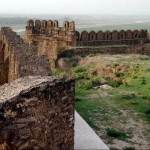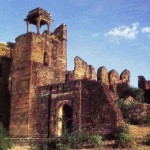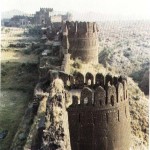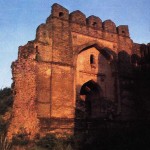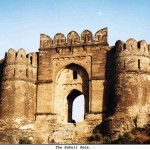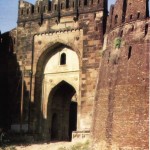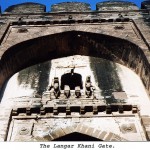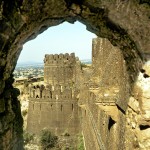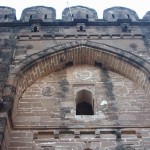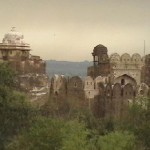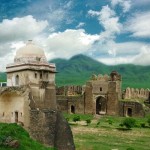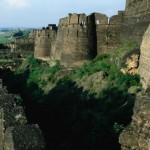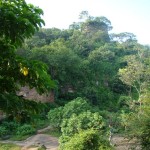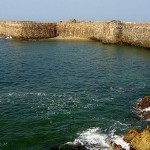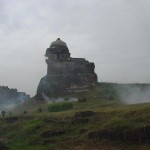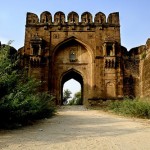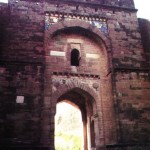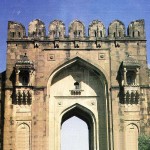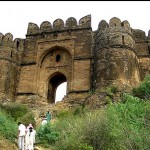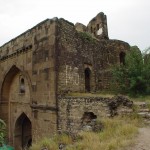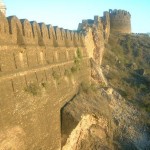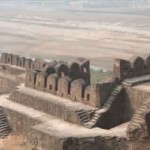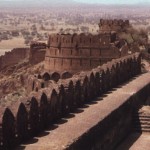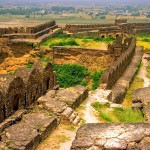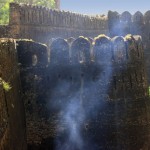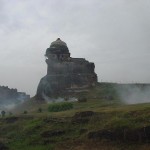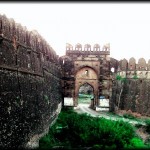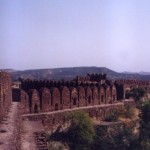Rohtas Fort is a garrison fort built by the great Afghan king Sher Shah Suri. This fort is about 4 km in circumference and the first example of the successful amalgamation of Pukhtun and Hindu architecture in the IndianName of fort
Sher Shah Suri named Qila Rohtas after the famous Rohtasgarh Fort in Shahabad district near Baharkunda, Bihar which he captured from the Raja of Rohtas Hari Krishan Rai in 1539. Rohtasgarh is situated on the upper course of the river Son, 20 37’ N and 85 33’E. It was built by Harish Chandra of the Solar dynasty and was named after his son Rohitasva after whom the fort (Rohtasgarh) was named.
Reasons of construction
Sher Shah constructed Qila Rohtas to block Emperor Humayun’s return to India after defeating him in the Battle of Kanauj. This fort lies on the old GT road between the North (Afghanistan) to the Plains of Punjab. It blocked the way from Peshawar to Lahore. The other reason was to suppress the local tribe of this region Potohar called Gakhars who were allies of Humayun and refused their allegiance to Sher Shah Suri. The Emperor instructed the local Janjua Rajput tribe to help construct the fort to crush the Gakhars[1] when the latter became openly defiant and persecuting labourers who attended the construction.
The Fort was built by Todar Mal under orders of Sher Shah.
“ Sher Sháh threatened to construct such a fort in that country that it should not only effectually restrain the Ghakkars, but also the passage of the Mughals. He therefore himself made a tour through the hills of Girjhák Ninduna [mountains circumjacent], * and finding a fit spot, he laid the foundations of the fort, which he called Rohtás.
Besides that, he sent a large force against Ráí Sárang, the Ghakkar, and not only was the country subdued, and the hill of Balnáth plundered, which was then the residence of the Dárogha of that tract, but the daughter of its chief was taken prisoner, and conducted before Sher Sháh, who presented her to Khawás Khán; upon which Ráí Sárang, they relate, sent a quantity of [hemp] blankets and millet to Sher Sháh, with the remark that in such only consisted their raiment and food, besides which they could afford nothing; according to others, he sent a lion’s skin and some [arrows] spears, which he said was their only property. With this conduct, however, Sher Sháh was by no means satisfied. Sárang [Sárang’s troops] being weakened by [skirmishes] the attacks of the holy warriors, and greatly reduced and straitened, submitted himself in person to Sher Sháh, who ordered him to be flayed alive, and his skin to be filled with straw, and so pay the penalty of his misdeeds.
Sher Sháh issued farmáns to complete the fortifications of Rohtás; but Todar Khatri represented that the Ghakkars, to whom that country belonged, would not allow any one to work for wages; and that they had agreed amongst themselves, upon oath, to expatriate every person that should contravene their wishes. Sher Sháh, in answer, told him [that he should not be allowed to give up that work, which he only wished to do in consequence of his greediness for gold]* that the work did not seem to advance under his superintendence, and that a man who was fond of money, and was alarmed about disbursing it, would never accomplish the king’s designs.
Todar, on the reception of this fresh command, fixed first a golden ashrafí as the enormous remuneration for one stone, which induced the [Kakers] Ghakkars to flock to him in such numbers that afterwards a stone was paid with a rupee, and this pay gradually fell to five tankas, till the fortress was completed.
Location
Qila Rohtas is situated in a gorge approximately 16 km NW of Jhelum and 7 km from Dina. It was constructed on a hillock where the tiny Kahan river meets another rainy stream called Parnal Khas and turns east towards Tilla Jogian Range. The fort is about 300 feet above its surroundings. It is 2660 feet (818 meters) above sea level and covers an area of 12.63 acres. Qila Rohtas is a garrison fort and could hold a force of up to 30,000 men. Due to its location, massive walls, trap gates and 3 Baolis (stepped wells) it could withstand a major siege although it was never besieged.
Most of the fort was built with ashlar stones collected from its surrounding villages such as Tarraki village. Some part of the fort were built with bricks. The fort is irregular in shape and follows the contours of the hill it was constructed on. The fort is exactly 5.2 km in circumference. A 533 meter long wall divides the citadel (for the Chieftain) from other parts of the fort.
The fortification has 68 bastions (towers) at irregular intervals. Out of the 3 Baolis, one of them is in the citadel and the rest are in the other parts of the fort. One of the Gates (Langar Khani) opens into the citadel and is a trap gate because it is in the direct line of fire of the bastions.
The Khwas Khani gate is an example of double walling. A small enclave on the western side is a citadel within a citadel. It is accessible by only one gate and also had a very fine Baoli which suggests that it was meant for the Chief and his family. In this citadel there is a beautiful Mosque called the Shahi Mosque (Not to be confused with the one in Lahore). There are no palaces in the Fort except for a structure built by Raja Man Singh called the Haveli of Man Singh. It is built on the highest point of the citadel.
Fortification wall
The height of the outer wall varies between 10 and 18 meters. Its thickness varies between 10 and 13 meters. The wall has 2 or 3 terraces and varies in thickness, the maximum being 13 meters near the Mori Gate. The terraces are linked by staircases. The topmost terrace has merlon-shaped battlements. Muskets can be fired from these battlements. Soldiers could also pour molten lead over the walls.
The wall is built in sandstone laid in lime mortar mixed with brick. The gates are in grey ashlar masonry. Some portions have been built using burnt brick.
The gates
The Rohtas Fort has the following 12 gates. All of them are built in ashlar stone.
Sohail Gate
This gate is the best example of masonry in use in the time of Sher Shah. It derives its name from a Saint names Sohail Bukhari buried in the south-western bastion of the gate. Others say that it was names after the Sohail Star which rises on this side of the fort.
It is a double gate rectangular in shape. It is 21.34 meters (70 feet) high, 20.73 meters (68 feet) wide and 15 meters (50 feet) deep. The central archway is 4.72 meters (15 feet) wide. It has an inner and an outer arch which is decorated with beautiful and simple motifs of sunflower. This decoration is repeated in all parts of the Qila.
There are balconies on either side of the central arch. These balconies have a small dome and their sides and bottom are also decorated. Unlike other parts of the Qila which has been built in Afghan-Persian style, the balcony is an example of Hindu architecture. These same balconies can be seen in Haveli Man Singh. There is a small window in the middle of the outer arch. This window is different from the two balconies to either side of the outer arch. It is much simpler that these two balconies.
There are seven merlons on this gate. The bastions are with battlements which have loopholes. These bastions have three levels on the inside. These can be seen if one zooms in the Sohail Gate picture.
The inner side of the gate mirrors the outside but has less decoration. There are no battlements towards the inside and no balconies either. The rooms in the upper storey of this gate have windows that open towards the inside of the Qila. Like the outer arch there is a small window in the middle of the inner arch. The gate now houses a Visitors information center and a Museum set up by the Himalayan Wildlife Foundation.
Shah Chandwali Gate
This gate links the citadel to the main fort. It is named after a Saint Shah Chandwali who refused to get his wages for working on this gate. The saint died while still on work and was buried near the gate. His shrine still stands to this day.
This gate is also a double gate. The outer gate, the entrance of which is from the citadel is 13.3 meters wide and 8.23 meters deep. The inner gate is a simple archway which is 3.66 meters wide.
Kabuli Gate
This gate opens to the west and is named “Kabuli” because it faces Kabul. It is a double gate and its opening is 3.15 meters (10 feet) wide. It has two bastions on each side. The gate has 5 battlements on top and has stairs leading up to it from the outside. On the southern side of the gate is the Shahi (Royal) Mosque because of which many people also call it Shahi (Royal) Darwaza (Gate or Door). There is a Baoli near this gate.
Shishi Gate
The gate derives its name from the beautiful glazed tiles used to decorate its outer arch. These tiles are the earliest examples of this technique which was later refined in Lahore. These tiles are blue in color.
An inscription on the left side of the gate gives the date of construction of the fort. The inscription is in Persian and is translated as follows
In the Hijri Year 948 came the exalted At that time constructed the great fort The emperor is Sher, with long life
There is no match to his good fortune It was completed by Shahu Sultan the Hijri year 948 is 1541 CE.
Langar Khani Gate
It is a double gate 15.25 meters (50 feet) high, 3.5 meters (11.5 feet) wide with a central arched opening. The oouter arch has a small window like the Sohail Gate. The outer opening leads to a Langar Khana (Mess or Canteen).
There are two bastions on either side of the gate which have kitchen, stores and a well for water. The opening of this gate is L shaped. As soon as one enters from the outer gate one has to turn right.
Talaqi Gate
This gate is 15.25 meter high and 13.8 meter wide with two bastions on either side. This gates name derives from “Talaq” (divorce). According to a legend, Prince Sabir Suri entered the gate and had an attack of fever which proved fatal. This was regarded as a bad omen and the name became “Talaqi”.
Mori or Kashmiri Gate
The gate opens to the north and faces Kashmir. This gate opens into one chamber which opens into another.
Khwas Khani Gate
This gate is named after one of Sher Shah Suri’s greatest general, Khwas Khan. This was the original entrance to the Qila (Fort) because outside the gate lies the old GT Road.
It is a double gate. The outer gate is 12.8 meter wide (42 feet) and 8 meter (26 feet) deep. This gate has a bastion and a defensive wall on each side. On the bastions canons could be deployed. The inner and outer gates are almost mirror images of each other. The top of the gate has five battlements. All of these have loopholes as well as machicolation. Unlike other gates of this Qila, the inner side of the gate has five battlements.
The inner and outer arches have sunflower motifs like the Sohail Gate. The gate also has a room which has windows opening to the inside and the outside.
It is pertinent to mention here that when the Gakhars refused their allegiance to Sher Shah Suri, he launched an expedition to punish them. This resulted in the capture of the Gakhar chief Sarang Khan and his daughter. Sarang Khan was then killed. His daughter was then married to Sher Shah’s favourite general Khwas Khan.
Gatali Gate
It is a single gate 9.15 meter high and 6.1 meter deep. This gate faces to the village Gatali Ford(ravine) which is called also Patan Gatiali or Gatiyalian, the important point to cross the River Jhelum for the Kashmir Vally, thus the name.
Tulla Mori Gate
This is an entrance rather than a gate. It is on the eastern side of the fort. It is about 2 meters wide. There is a bastion next to this entrance.
Pipalwala Gate
This is a small entrance like the Tulla Mori Gate. It is 2.13 meter wide.
Sar Gate
This is a small entrance. There is a bastion next to this gate. There is a Baoli next to this gate. It is called “Sar” because “Sar” means water.


